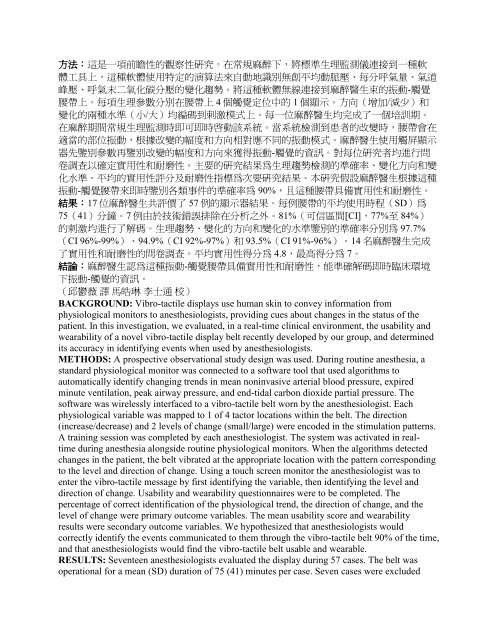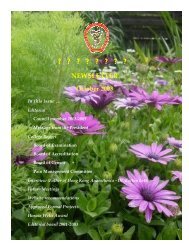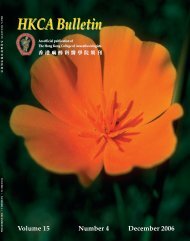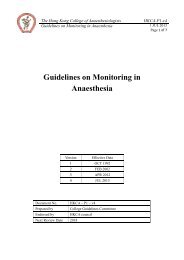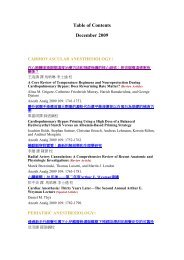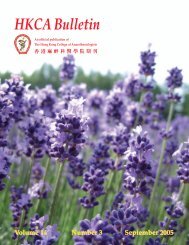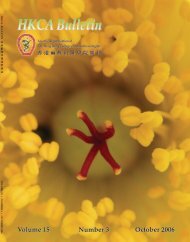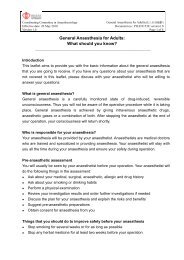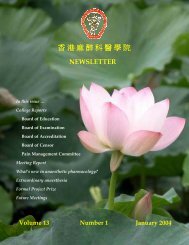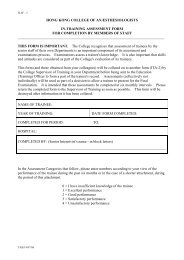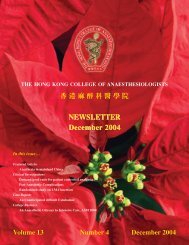Table of Contents — September 2012, 115 (3)
Table of Contents — September 2012, 115 (3)
Table of Contents — September 2012, 115 (3)
Create successful ePaper yourself
Turn your PDF publications into a flip-book with our unique Google optimized e-Paper software.
方 法 : 這 是 一 項 前 瞻 性 的 觀 察 性 研 究 。 在 常 規 麻 醉 下 , 將 標 準 生 理 監 測 儀 連 接 到 一 種 軟<br />
體 工 具 上 , 這 種 軟 體 使 用 特 定 的 演 算 法 來 自 動 地 識 別 無 創 平 均 動 脈 壓 、 每 分 呼 氣 量 、 氣 道<br />
峰 壓 、 呼 氣 末 二 氧 化 碳 分 壓 的 變 化 趨 勢 。 將 這 種 軟 體 無 線 連 接 到 麻 醉 醫 生 束 的 振 動 - 觸 覺<br />
腰 帶 上 。 每 項 生 理 參 數 分 別 在 腰 帶 上 4 個 觸 覺 定 位 中 的 1 個 顯 示 。 方 向 ( 增 加 / 減 少 ) 和<br />
變 化 的 兩 種 水 準 ( 小 / 大 ) 均 編 碼 到 刺 激 模 式 上 。 每 一 位 麻 醉 醫 生 均 完 成 了 一 個 培 訓 期 。<br />
在 麻 醉 期 間 常 規 生 理 監 測 時 即 可 即 時 啟 動 該 系 統 。 當 系 統 檢 測 到 患 者 的 改 變 時 , 腰 帶 會 在<br />
適 當 的 部 位 振 動 , 根 據 改 變 的 幅 度 和 方 向 相 對 應 不 同 的 振 動 模 式 。 麻 醉 醫 生 使 用 觸 屏 顯 示<br />
器 先 鑒 別 參 數 再 鑒 別 改 變 的 幅 度 和 方 向 來 獲 得 振 動 - 觸 覺 的 資 訊 。 對 每 位 研 究 者 均 進 行 問<br />
卷 調 查 以 確 定 實 用 性 和 耐 磨 性 。 主 要 的 研 究 結 果 為 生 理 趨 勢 檢 測 的 準 確 率 、 變 化 方 向 和 變<br />
化 水 準 。 平 均 的 實 用 性 評 分 及 耐 磨 性 指 標 為 次 要 研 究 結 果 。 本 研 究 假 設 麻 醉 醫 生 根 據 這 種<br />
振 動 - 觸 覺 腰 帶 來 即 時 鑒 別 各 類 事 件 的 準 確 率 為 90%, 且 這 種 腰 帶 具 備 實 用 性 和 耐 磨 性 。<br />
結 果 :17 位 麻 醉 醫 生 共 評 價 了 57 例 的 顯 示 器 結 果 。 每 例 腰 帶 的 平 均 使 用 時 程 (SD) 為<br />
75(41) 分 鐘 。7 例 由 於 技 術 錯 誤 排 除 在 分 析 之 外 。81%( 可 信 區 間 [CI],77% 至 84%)<br />
的 刺 激 均 進 行 了 解 碼 。 生 理 趨 勢 、 變 化 的 方 向 和 變 化 的 水 準 鑒 別 的 準 確 率 分 別 為 97.7%<br />
(CI 96%-99%)、94.9%(CI 92%-97%) 和 93.5%(CI 91%-96%)。14 名 麻 醉 醫 生 完 成<br />
了 實 用 性 和 耐 磨 性 的 問 卷 調 查 。 平 均 實 用 性 得 分 為 4.8, 最 高 得 分 為 7。<br />
結 論 : 麻 醉 醫 生 認 為 這 種 振 動 - 觸 覺 腰 帶 具 備 實 用 性 和 耐 磨 性 , 能 準 確 解 碼 即 時 臨 床 環 境<br />
下 振 動 - 觸 覺 的 資 訊 。<br />
( 邱 鬱 薇 譯 馬 皓 琳 李 士 通 校 )<br />
BACKGROUND: Vibro-tactile displays use human skin to convey information from<br />
physiological monitors to anesthesiologists, providing cues about changes in the status <strong>of</strong> the<br />
patient. In this investigation, we evaluated, in a real-time clinical environment, the usability and<br />
wearability <strong>of</strong> a novel vibro-tactile display belt recently developed by our group, and determined<br />
its accuracy in identifying events when used by anesthesiologists.<br />
METHODS: A prospective observational study design was used. During routine anesthesia, a<br />
standard physiological monitor was connected to a s<strong>of</strong>tware tool that used algorithms to<br />
automatically identify changing trends in mean noninvasive arterial blood pressure, expired<br />
minute ventilation, peak airway pressure, and end-tidal carbon dioxide partial pressure. The<br />
s<strong>of</strong>tware was wirelessly interfaced to a vibro-tactile belt worn by the anesthesiologist. Each<br />
physiological variable was mapped to 1 <strong>of</strong> 4 tactor locations within the belt. The direction<br />
(increase/decrease) and 2 levels <strong>of</strong> change (small/large) were encoded in the stimulation patterns.<br />
A training session was completed by each anesthesiologist. The system was activated in realtime<br />
during anesthesia alongside routine physiological monitors. When the algorithms detected<br />
changes in the patient, the belt vibrated at the appropriate location with the pattern corresponding<br />
to the level and direction <strong>of</strong> change. Using a touch screen monitor the anesthesiologist was to<br />
enter the vibro-tactile message by first identifying the variable, then identifying the level and<br />
direction <strong>of</strong> change. Usability and wearability questionnaires were to be completed. The<br />
percentage <strong>of</strong> correct identification <strong>of</strong> the physiological trend, the direction <strong>of</strong> change, and the<br />
level <strong>of</strong> change were primary outcome variables. The mean usability score and wearability<br />
results were secondary outcome variables. We hypothesized that anesthesiologists would<br />
correctly identify the events communicated to them through the vibro-tactile belt 90% <strong>of</strong> the time,<br />
and that anesthesiologists would find the vibro-tactile belt usable and wearable.<br />
RESULTS: Seventeen anesthesiologists evaluated the display during 57 cases. The belt was<br />
operational for a mean (SD) duration <strong>of</strong> 75 (41) minutes per case. Seven cases were excluded


